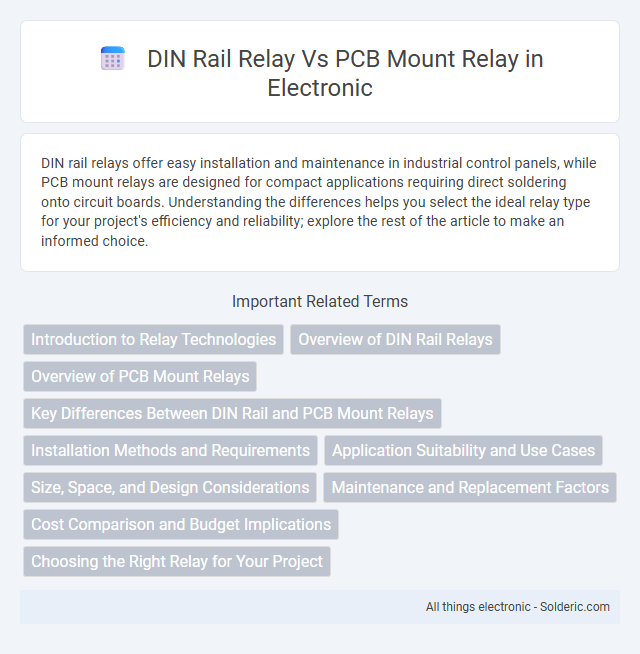DIN rail relays offer easy installation and maintenance in industrial control panels, while PCB mount relays are designed for compact applications requiring direct soldering onto circuit boards. Understanding the differences helps you select the ideal relay type for your project's efficiency and reliability; explore the rest of the article to make an informed choice.
Comparison Table
| Feature | DIN Rail Relay | PCB Mount Relay |
|---|---|---|
| Mounting Type | Mounted on DIN rail | Soldered directly on PCB |
| Application | Industrial control panels, automation systems | Compact electronics, PCB circuits |
| Size | Larger, bulkier | Compact, space-saving |
| Installation | Tool-assisted snap on/off | PCB soldering required |
| Replacement | Easy and quick replacement | Requires desoldering |
| Current Rating | Generally higher, up to 40A or more | Typically lower, up to a few amps |
| Durability | Robust for harsh environments | Suitable for controlled environments |
| Wiring | Supports screw terminal wiring | PCB trace connections |
Introduction to Relay Technologies
DIN rail relays offer robust, modular installation ideal for industrial control panels, enabling easy maintenance and wire management, while PCB mount relays provide compact, high-speed switching directly on circuit boards for electronic devices. Your choice depends on application requirements such as load capacity, space constraints, and integration needs, with DIN rail relays supporting higher power loads and PCB relays favoring automation and signal processing tasks. Understanding differences in mounting style, voltage ratings, and switching capabilities is essential for optimizing relay technology in your projects.
Overview of DIN Rail Relays
DIN rail relays are industrial-grade components designed for easy installation on standardized DIN rails commonly used in control panels and automation systems. They offer robust construction, high durability, and efficient space utilization, making them ideal for complex electrical setups requiring quick maintenance or replacement. Your control system benefits from enhanced organization and reliable switching performance when using DIN rail relays.
Overview of PCB Mount Relays
PCB mount relays are compact electromechanical switches designed for direct installation onto printed circuit boards, facilitating efficient space usage in electronic devices. They offer rapid switching capabilities, low coil power consumption, and are suitable for controlling low to moderate current loads in applications such as telecommunications, industrial automation, and consumer electronics. Their standardized pin configurations and solderable terminals ensure reliable electrical connections and simplify automated assembly processes.
Key Differences Between DIN Rail and PCB Mount Relays
DIN rail relays are designed for easy installation on standardized metal rails within industrial control panels, offering robust housing and quick wiring capabilities suitable for high-current applications. PCB mount relays are compact components intended for direct soldering onto printed circuit boards, enabling automated assembly and ideal for low to moderate current loads in electronic devices. Key differences include mounting method, size, current handling capacity, and application environment, with DIN rail relays favored for industrial setups and PCB mount relays used in compact, low-power circuits.
Installation Methods and Requirements
DIN rail relays are designed for easy installation on standardized metal rails within electrical panels, providing quick mounting and secure attachment without the need for additional hardware. PCB mount relays require soldering directly onto printed circuit boards, demanding precise alignment and soldering equipment for proper integration. Choosing between these depends on your project's space constraints and the desired installation efficiency.
Application Suitability and Use Cases
DIN rail relays are ideal for industrial automation, control panels, and heavy-duty electrical systems requiring easy installation and maintenance within standardized enclosures. PCB mount relays suit compact electronic devices, consumer electronics, and circuit boards where space-saving and precise electronic switching are critical. Your choice depends on whether the application demands robustness and modularity (DIN rail) or miniaturization and integration (PCB mount).
Size, Space, and Design Considerations
DIN rail relays typically offer larger size and robust housing designed for easy snap-on mounting in industrial control panels, optimizing space vertically along the rail. PCB mount relays are compact and suited for printed circuit boards, enabling dense, low-profile installations where minimal footprint and direct electrical integration are critical. Design considerations favor DIN rail relays for modular, scalable systems requiring quick replacement and durability, while PCB mount relays excel in compact electronic devices prioritizing space efficiency and precise circuit alignment.
Maintenance and Replacement Factors
DIN rail relays offer simplified maintenance due to their modular design, enabling quick replacement without disturbing adjacent components, which is ideal for industrial environments requiring frequent servicing. PCB mount relays, integrated directly onto circuit boards, often necessitate de-soldering and re-soldering during replacement, increasing downtime and requiring precise technical skills. The ease of maintenance and reduced replacement time make DIN rail relays preferable in systems prioritizing operational continuity and rapid fault recovery.
Cost Comparison and Budget Implications
DIN rail relays generally entail higher initial costs due to their robust housing and easier installation in industrial settings, impacting overall project budgets. PCB mount relays offer a more cost-effective solution for compact, low-volume applications, reducing expenses on assembly and space requirements. Budget-conscious projects benefit from evaluating installation needs and operational environments to determine the most economical relay choice.
Choosing the Right Relay for Your Project
Selecting the right relay for your project depends on factors such as installation space, load requirements, and ease of maintenance. DIN rail relays offer modularity and quick replacement ideal for industrial control panels, while PCB mount relays provide compact integration suitable for electronic circuit boards with limited space. Assess voltage ratings, current capacity, and environmental conditions to ensure optimal performance and reliability.
DIN rail relay vs PCB mount relay Infographic

 solderic.com
solderic.com